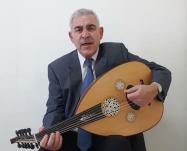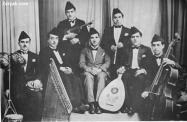(52 results found)
3. Music by Salah al-Kuwayti
… Salah al-Kuwayti ’s composition featuring an Iraqi-style introduction ( maqoudimah ), violin taqsim , … Audio Examples (CDs 1-5) … Makam … Ethnography … Ethnomusicological Research … Iraq … Jewish musicians … Maqam … Baghdadi … 3. Music by Salah al-Kuwayti …
1. Maqam Rast
… 21A, item 2; radio tape 1158). Al-‘Amari was an expert in Iraqi music and even wrote manuscripts on maqam theory. The … Audio Examples (CDs 1-5) … Makam … Ethnography … Ethnomusicological Research … Iraq … Jewish musicians … Maqam … …
Jewish Professional Musicians in Iraq and Israel Audio Examples
… Jewish Professional Musicians in Iraq and Israel, Revisited … 55 … 7 … 41859 … Dissertation Examples CDs (1-5) are a compilation of the music discussed and analyzed in the Warkov dissertation “ … field recordings: The performers on these 5 CDs are mostly Iraqi-Jewish musicians who recorded these items for the …
Yossef (Yusuf) Zaarur
… Childhood and early musical career Yossef (Yusuf) Zaarur (يوسف زعرور) was born … the religious vocal repertoire of his community and to the Iraqi Arab singing style. Yossef is not to be confused with … to musicians—still prevalent in early-twentieth century Iraqi Jewish society—as well the shifts in attitudes towards …
Moshe Havusha
… Moshe Havusha was born in 1961 into a family of Iraqi immigrants in Jerusalem’s Beit Israel neighborhood. He absorbed the ancient Iraqi traditions of prayer and piyyutim from his … traditions are based on both Syrian (“Halabi”) and Egyptian musical styles. Today, Havusha, who still lives in the Beit …
Pizmon al masaot mi-Bagdad ad kever Yehezkel ha-navi.
… [number] day is...” On this song see, Amnon Shiloah, The musical tradition of Iraqi Jews (Or Yehuda, 1983), no. 59, pp. 126-7 … From the …
Yehi shalom (zemer le-berit milah)
… 2 onwards) is still very popular among descendants of Iraqi Jews in Israel. Compare with the version in Amnon Shiloah, The musical tradition of Iraqi Jews (Or Yehuda, 1983), no. 51, pp. 116-7 … From the …
Nahôn libbo is hujire – Whole-heartedly is the fearful believer
… of the exiled in the Promised Land. The inclusion of this Iraqi Jewish tune adapted from Idelsohn’s Thesaurus of Hebrew Oriental Music (1923b: 140, no. 193) is an unexpected turn after four … the contrast between the Eastern European and the Iraqi musical worlds by means of two widely separated keys, …
Fog al-Nakhal (فوق النخل): Multicultural and Transnational Journeys of an Iraqi Folksong
… by its refrain between the stanzas. Usually recognized as Iraqi, “Fog al-Nakhal” also appears in the repertoire of … Eastern communities and nations. In the context of the Iraqi Maqam ( al-maqam al-Iraqi ), this catchy song in maqam … history is complex, revealing a number of interrelated musical and textual settings. Looking into the information …
Armand Sabah
… Israel with his family at age ten. His father came from a musical family related to the renowned Moroccan singer and composer Sami Elmagribi. The love of music in his household was evident through the constant … to play the oud privately. His father introduced him to an Iraqi oud player from Avraham Salman's ensemble in the Kol …







